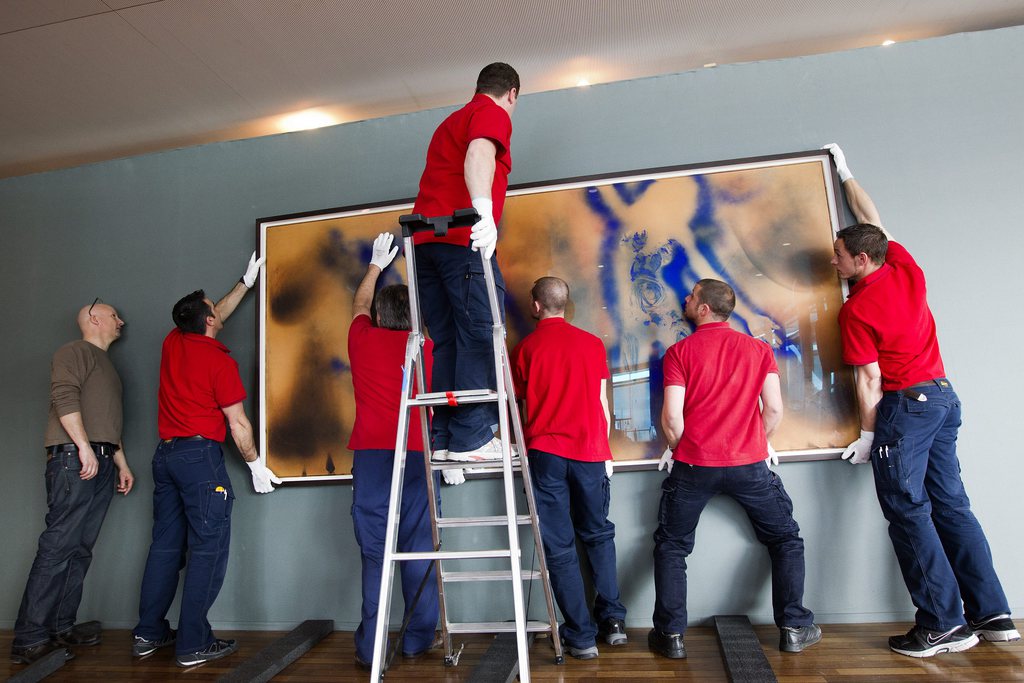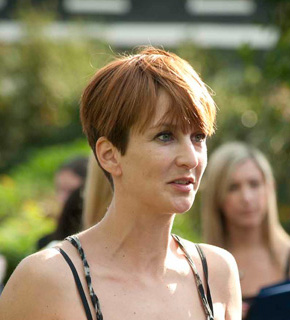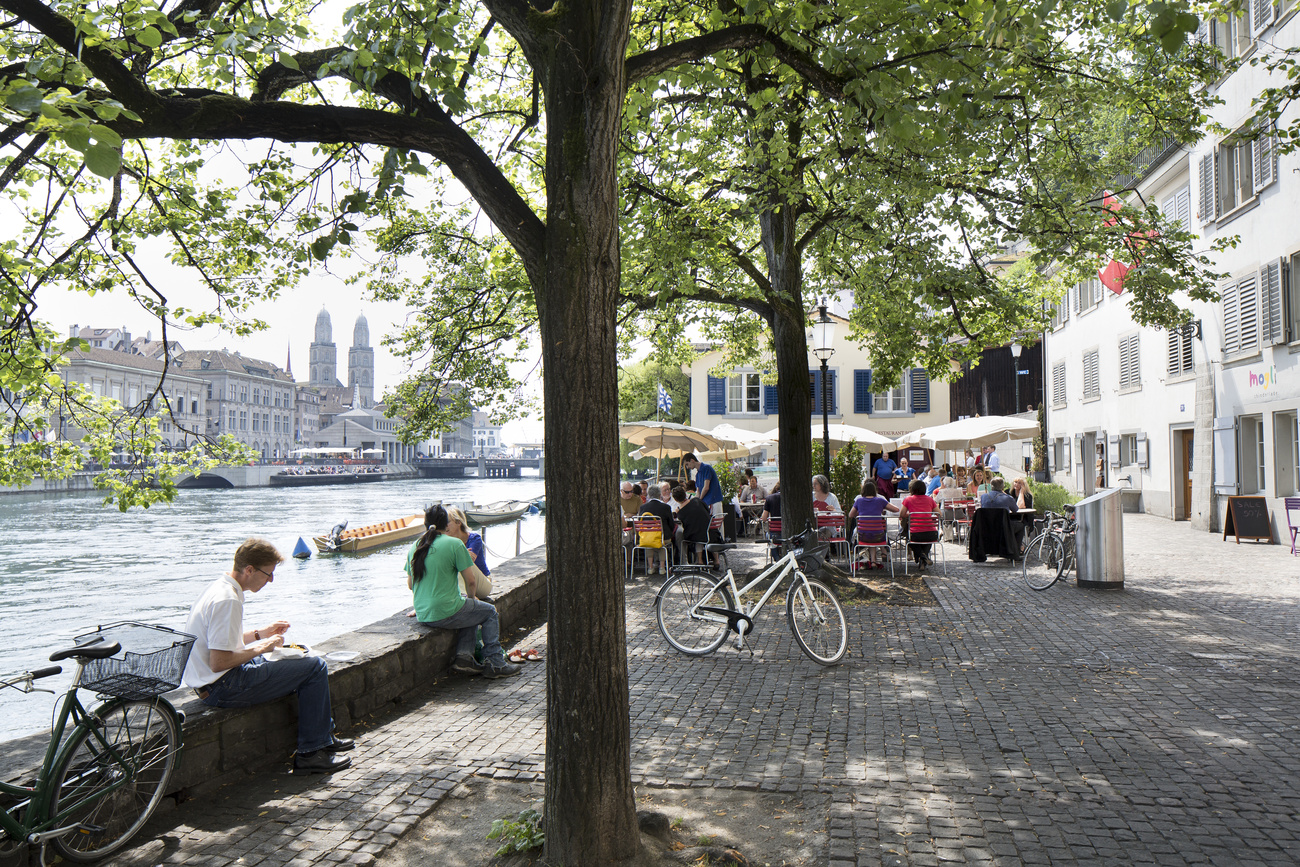Why contemporary art is breaking auction records

The works of today’s artists are sold at dizzying prices that break one record after another. This trend is due to a new generation of collectors, explains Nadia Berri, a Swiss artist who teaches at Sotheby’s Institute of Art in London.
In the space of ten minutes, the bids climbed to $142.4 million (CHF128.5 million), making Three studies of Lucian Freud, a triptych painted by Francis Bacon in 1969, the most expensive work of art in history. It sold at a Christie’s auction in New York on November 13.
Several other records were broken at the same auction and one held the next day at Sotheby’s (see box).
Despite the ongoing global economic crisis, the international market for contemporary art has grown by 15% in the past year, exceeding the billion euro mark for the first time, according to Artprice, a company that provides information on the art market. This record for contemporary art was set while the art market as a whole registered a decline of 2.4%.
Nadia Berri was born in Zurich. Since 2008 she has taught contemporary art history to adults at Sotheby’s Institute of Art and to children at the Tate Modern museum.
She is interested in American composer John Cage’s idea that “art is purposeless play” but thinks that play is never purposeless.
She is active in collective projects like LUPA (Lock Up Performance Art), which went on in London from 2011 to 2013: artists exhibited in a garage one evening a month, and the public did not just look but often participated too.
Her work at LUPA included Now, Voyager, a performance with a giant red balloon and a pump. She describes her art as multidisciplinary as is shown in a recent work, Darren, a video collection of screams by passers-by in the street.
swissinfo.ch: How do you go about evaluating contemporary work?
Nadia Berri: It’s one thing to understand a work of art and its true message, another thing is how much a work of art pleases the public. Taste is personal and one should not let oneself be influenced; one has to be very critical. A work of art on show in a gallery does not mean it is a good work of art – it just appealed to the personal taste of the art dealer. Promotion and pricing go together.
As always in art, there are fashions and periods: this is the heyday of the contemporary. Today so many new collectors, Russians and Arabs, want these works and many put their trust in their art adviser, who may be right, but often too much advice does not leave room for freedom of choice and individual creativity.

swissinfo.ch: Why are new collectors so keen on contemporary art?
N.B.: Because it’s glamorous, it’s “intellectual”, it makes the difference between the new collectors who acquire it. There are also some serious collectors who really understand art: art that is really striking and sends a message. But this trend for the contemporary is being driven by the new collectors.
The new price record for a work of art set by Francis Bacon’s triptych on November 13 topped the previous one of $119.9 million set by Edvard Munch’s The Scream in May 2012 at a Sotheby’s auction in New York.
The Christie’s auction on November 13 also yielded the top price for a work by a living artist: the sculpture Balloon Dog (Orange) by Jeff Koons, which was sold for $58.4 million. Personal price records for artists were also set by works of Christopher Wool, Ad Reinhardt, Donald Judd and Willem de Kooning.
The following day, a Sotheby’s auction set new personal price records for Andy Warhol (whose Silver Car Crash sold for $105 million), Cy Twombly, Agnes Martin, Martin Kippenberger, Brice Marden, Mark Bradford and the group of artists known as Bruce High Quality Foundation.
swissinfo.ch: Who is in fashion right now?
N.B.: There are always situations that I call the “Murillo Syndrome”, in which a collector starts to buy something or is advised to buy something that someone else has discovered, such as at the moment Oscar Murillo, the Colombian artist. His popularity reminds me of Jean-Michel Basquiat’s in the 1980s, when Annina Nosei, his dealer, was presenting him as the “true” voice of the street.
swissinfo.ch: What about Swiss artists?
N.B.: Alberto Giacometti is a great artist and his name is linked to impressive sums, whereas Paul Klee, though he is a great artist too – the Tate Modern is dedicating a very fine exhibition to him – does not meet with the same success in auctions.
swissinfo.ch: Is there an artist who sells well at auctions not because of fashion but because of his message?
N.B.: Based on my experience, I would say Yves Klein. He was a French genius who succeeded in selling Zones de sensibilité picturale immatérielle [empty spaces] in Paris in exchange for gold which he then threw in the Seine. Klein [whose record at auction is for Le Rose du Bleu, sold in London in June 2012 for £23.56 million (CHF35 million)] is best known for his monochrome canvases, the most famous of which are blue. He wanted to achieve “the most perfect expression” of that colour, and after many attempts he succeeded – so much so that in 1956 he patented International Klein Blue, known in the art world as IKB.
With a billion dollars in investments, Sheikha Al-Mayassa bint Hamad bin Khalifa Al-Thani is the most influential person in the world of art, according to the journal ArtReview, which each year publishes a ranking of the 100 most important people in the business, from gallery owners to critics, and from collectors to artists themselves. She is a younger sister of the current emir of Qatar and is director of the Qatar Museums Authority.
Another woman, the German Beatrix Ruf, comes in seventh in the ranking. She is director of the contemporary art exhibition centre Kunsthalle Zurich and also sits on the Cultural Advisory Board of CERN in Geneva.
There are two Swiss in the top ten. Iwan Wirth, ranked third, is a gallery owner and art dealer in Zurich, and co-president and owner of Hauser & Wirth, one of the best-known galleries of modern and contemporary art in London, New York and Zurich. In fifth place is Hans Ulrich Obrist, also from Zurich, a curator, critic, art historian and co-director of the Serpentine Gallery in Hyde Park, London, one of the most important centres for modern and contemporary art.
swissinfo.ch: If you were able to recommend something to a true collector, what work would you suggest?
N.B.: Certainly Erased de Kooning drawing by the American painter and sculptor Robert Rauschenberg. It is a blank sheet of paper with an erased drawing by the abstract expressionist Willem de Kooning, dating from 1953. It is kept at the San Francisco Museum of Modern Art. In view of the history of this work there is no knowing what it would go for at auction.
swissinfo.ch: You are an artist and teacher: how do you combine the two activities?
N.B.: For me every class is like a performance. I teach art and offer practice-based workshops. These two realities are integrated and never separate. I also do my teaching in contexts that are very different from one another: Sotheby’s Institute of Art, the Tate Modern Gallery and the charity Bow Arts.
swissinfo.ch: Why is there an interest now for art courses provided by institutions attached to the major auction houses?
N.B.: At first Sotheby’s Institute of Art was “the school” of the auction house, but since 2002 it has been affiliated with the University of Manchester, although it continues to use the name of the auction house and has an exclusive relationship with it.
Art today means work opportunities. At Sotheby’s Institute of Art I have been teaching history of contemporary art since 2008. The courses have been growing. At the “Art & Business” course, for which I am one of the main lecturers, I started with about 25 students, but the numbers have doubled in the past three years.
swissinfo.ch: Who goes to these courses?
N.B.: Young people arrive in London from all over the world. The ones who take courses of this kind have two characteristics: a high level of education in the subject, often acquired in their country of origin, and money to invest in such high-level training. Sometimes it’s people changing careers too.
swissinfo.ch: Is London now the European capital of contemporary art?
N.B.: I would say yes, because all the trends converge here. There are the museums, the auction houses, the galleries – and the money. But there are also groups of artists who meet here, produce their art independently and share it with the public, without using intermediaries.
(Translated by Terence MacNamee)

In compliance with the JTI standards
More: SWI swissinfo.ch certified by the Journalism Trust Initiative










You can find an overview of ongoing debates with our journalists here . Please join us!
If you want to start a conversation about a topic raised in this article or want to report factual errors, email us at english@swissinfo.ch.